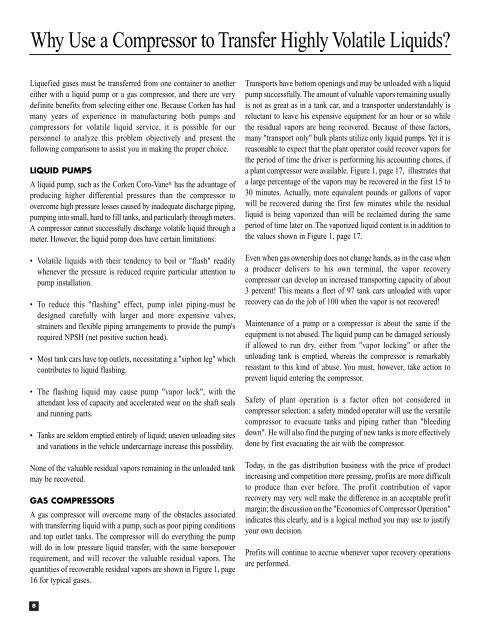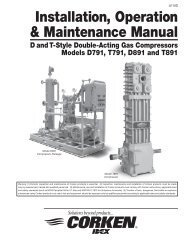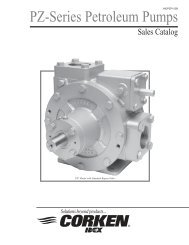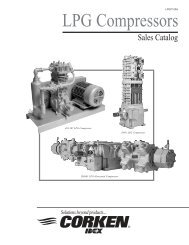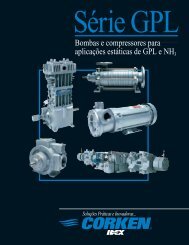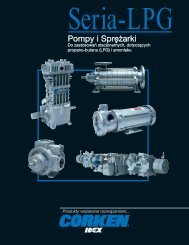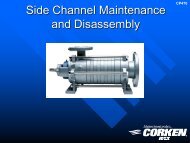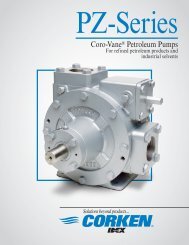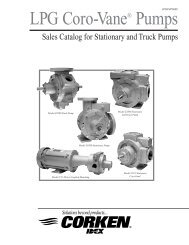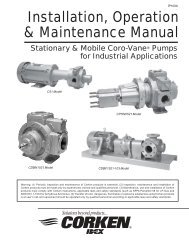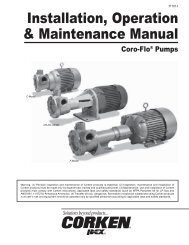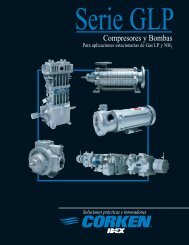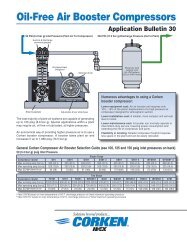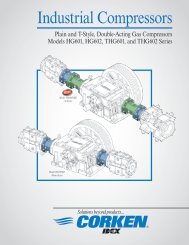CP370C SCR Selec Guide.qxd - Corken
CP370C SCR Selec Guide.qxd - Corken
CP370C SCR Selec Guide.qxd - Corken
You also want an ePaper? Increase the reach of your titles
YUMPU automatically turns print PDFs into web optimized ePapers that Google loves.
Why Use a Compressor to Transfer Highly Volatile Liquids?<br />
Liquefied gases must be transferred from one container to another<br />
either with a liquid pump or a gas compressor, and there are very<br />
definite benefits from selecting either one. Because <strong>Corken</strong> has had<br />
many years of experience in manufacturing both pumps and<br />
compressors for volatile liquid service, it is possible for our<br />
personnel to analyze this problem objectively and present the<br />
following comparisons to assist you in making the proper choice.<br />
LIQUID PUMPS<br />
A liquid pump, such as the <strong>Corken</strong> Coro-Vane ® has the advantage of<br />
producing higher differential pressures than the compressor to<br />
overcome high pressure losses caused by inadequate discharge piping,<br />
pumping into small, hard to fill tanks, and particularly through meters.<br />
A compressor cannot successfully discharge volatile liquid through a<br />
meter. However, the liquid pump does have certain limitations:<br />
• Volatile liquids with their tendency to boil or "flash" readily<br />
whenever the pressure is reduced require particular attention to<br />
pump installation.<br />
• To reduce this "flashing" effect, pump inlet piping-must be<br />
designed carefully with larger and more expensive valves,<br />
strainers and flexible piping arrangements to provide the pump's<br />
required NPSH (net positive suction head).<br />
• Most tank cars have top outlets, necessitating a "siphon leg" which<br />
contributes to liquid flashing.<br />
• The flashing liquid may cause pump "vapor lock", with the<br />
attendant loss of capacity and accelerated wear on the shaft seals<br />
and running parts.<br />
• Tanks are seldom emptied entirely of liquid; uneven unloading sites<br />
and variations in the vehicle undercarriage increase this possibility.<br />
None of the valuable residual vapors remaining in the unloaded tank<br />
may be recovered.<br />
GAS COMPRESSORS<br />
A gas compressor will overcome many of the obstacles associated<br />
with transferring liquid with a pump, such as poor piping conditions<br />
and top outlet tanks. The compressor will do everything the pump<br />
will do in low pressure liquid transfer, with the same horsepower<br />
requirement, and will recover the valuable residual vapors. The<br />
quantities of recoverable residual vapors are shown in Figure 1, page<br />
16 for typical gases.<br />
Transports have bottom openings and may be unloaded with a liquid<br />
pump successfully. The amount of valuable vapors remaining usually<br />
is not as great as in a tank car, and a transporter understandably is<br />
reluctant to leave his expensive equipment for an hour or so while<br />
the residual vapors are being recovered. Because of these factors,<br />
many "transport only" bulk plants utilize only liquid pumps. Yet it is<br />
reasonable to expect that the plant operator could recover vapors for<br />
the period of time the driver is performing his accounting chores, if<br />
a plant compressor were available. Figure 1, page 17, illustrates that<br />
a large percentage of the vapors may be recovered in the first 15 to<br />
30 minutes. Actually, more equivalent pounds or gallons of vapor<br />
will be recovered during the first few minutes while the residual<br />
liquid is being vaporized than will be reclaimed during the same<br />
period of time later on. The vaporized liquid content is in addition to<br />
the values shown in Figure 1, page 17.<br />
Even when gas ownership does not change hands, as in the case when<br />
a producer delivers to his own terminal, the vapor recovery<br />
compressor can develop an increased transporting capacity of about<br />
3 percent! This means a fleet of 97 tank cars unloaded with vapor<br />
recovery can do the job of 100 when the vapor is not recovered!<br />
Maintenance of a pump or a compressor is about the same if the<br />
equipment is not abused. The liquid pump can be damaged seriously<br />
if allowed to run dry, either from "vapor locking" or after the<br />
unloading tank is emptied, whereas the compressor is remarkably<br />
resistant to this kind of abuse. You must, however, take action to<br />
prevent liquid entering the compressor.<br />
Safety of plant operation is a factor often not considered in<br />
compressor selection: a safety minded operator will use the versatile<br />
compressor to evacuate tanks and piping rather than "bleeding<br />
down". He will also find the purging of new tanks is more effectively<br />
done by first evacuating the air with the compressor.<br />
Today, in the gas distribution business with the price of product<br />
increasing and competition more pressing, profits are more difficult<br />
to produce than ever before. The profit contribution of vapor<br />
recovery may very well make the difference in an acceptable profit<br />
margin; the discussion on the "Economics of Compressor Operation"<br />
indicates this clearly, and is a logical method you may use to justify<br />
your own decision.<br />
Profits will continue to accrue whenever vapor recovery operations<br />
are performed.<br />
8


